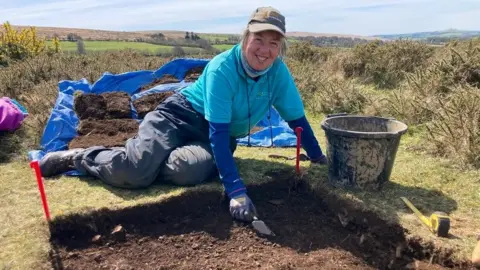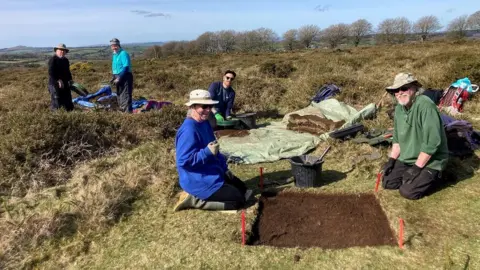Digs unearth Dartmoor's hunter-gatherer history
 DNPA
DNPAA five-week programme of archaeological digs has uncovered small pieces of stone that give clues about Dartmoor's hunter-gatherer past.
The pieces could help tell us more about those who lived in the area more than 10,000 years ago, experts say.
They have been found at various locations, Dartmoor National Park Authority (DNPA) said.
Emma Stockley, the project's leader, said the flint pieces give "tantalising clues" about the past.
They are though to be from the Mesolithic period, between 10,000 and 4,000BC.
DNPA said this was a time when rapid warming of the climate, following the end of the Ice Age, led to the spread of forests over Dartmoor.
 DNPA
DNPAPeople are known to have hunted in small groups for wild animals such as deer and wild auroch cattle and gathered berries and nuts.
Project workers have been looking for evidence of tools they used, and debris they left behind.
Ms Stockley, a University of Leicester PhD student and former DNPA employee, said: "I've always been fascinated by the idea of Mesolithic hunter-gatherers on Dartmoor and the tantalising clues that these tiny pieces of flint or chert offer us about how communities lived and made use of the surrounding landscape.
 DNPA
DNPA"Unlike Dartmoor's later archaeology, the archaeology from this period is much less obvious and visitors may be completely unaware of this formative time in Dartmoor's past."
A team of 50 volunteers have also been involved in the project.
DNPA archaeologist Dr Lee Bray said: "Not only will Emma's research add to our knowledge of this important period in Dartmoor's human past but it will also help us develop techniques for managing Dartmoor's archaeological heritage so the landscape is better understood, valued and looked after."

Follow BBC News South West on Twitter, Facebook and Instagram. Send your story ideas to [email protected].
